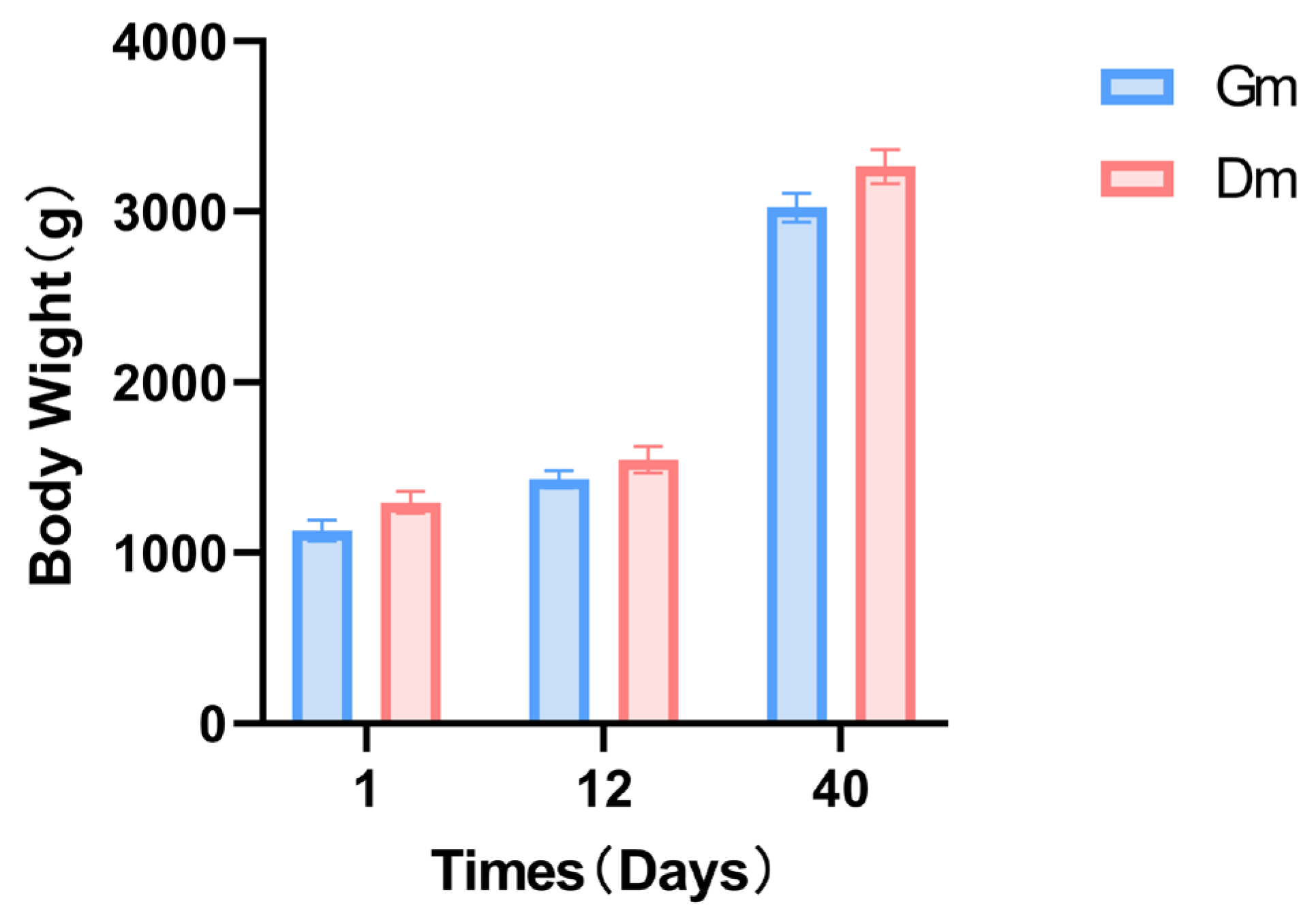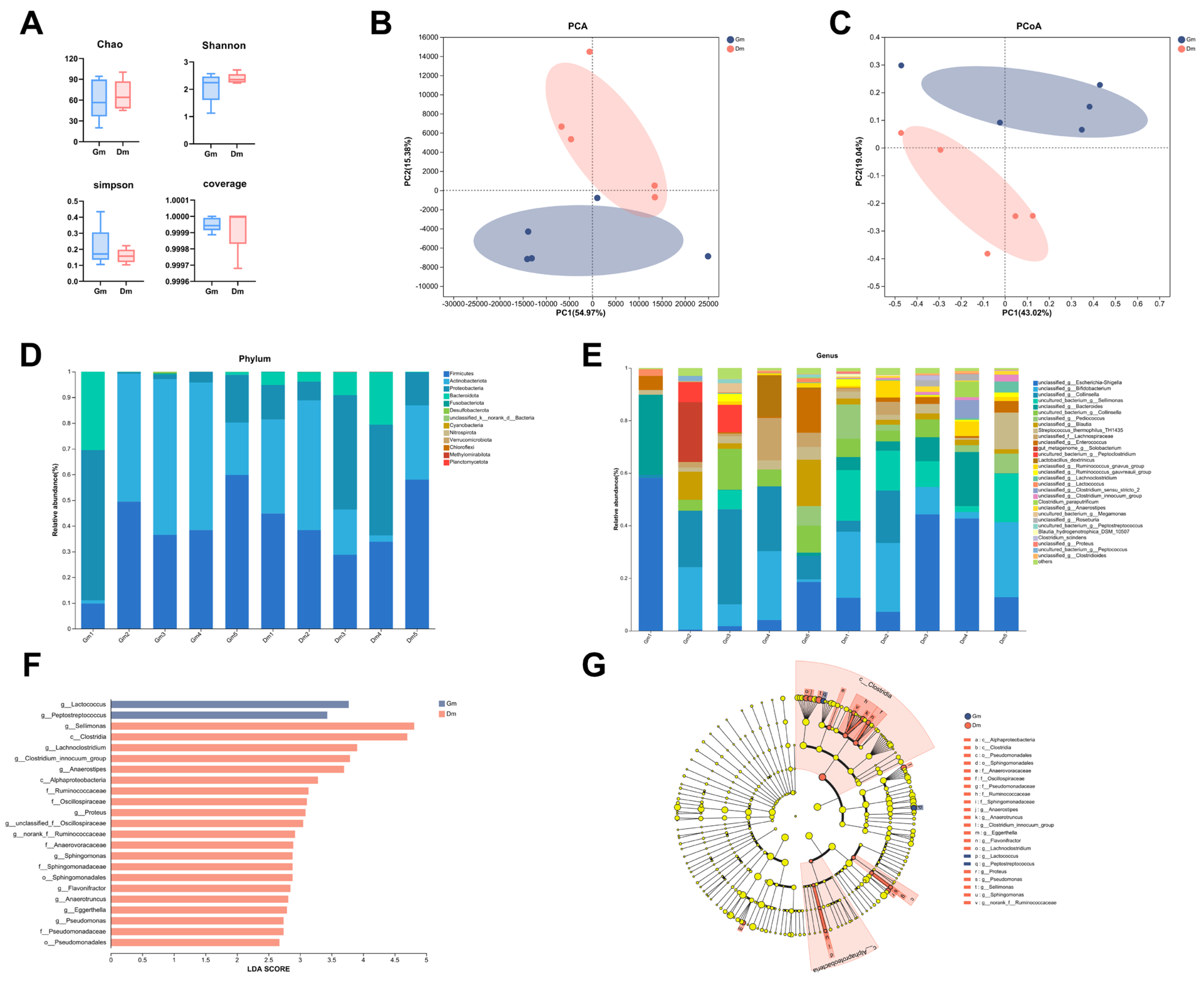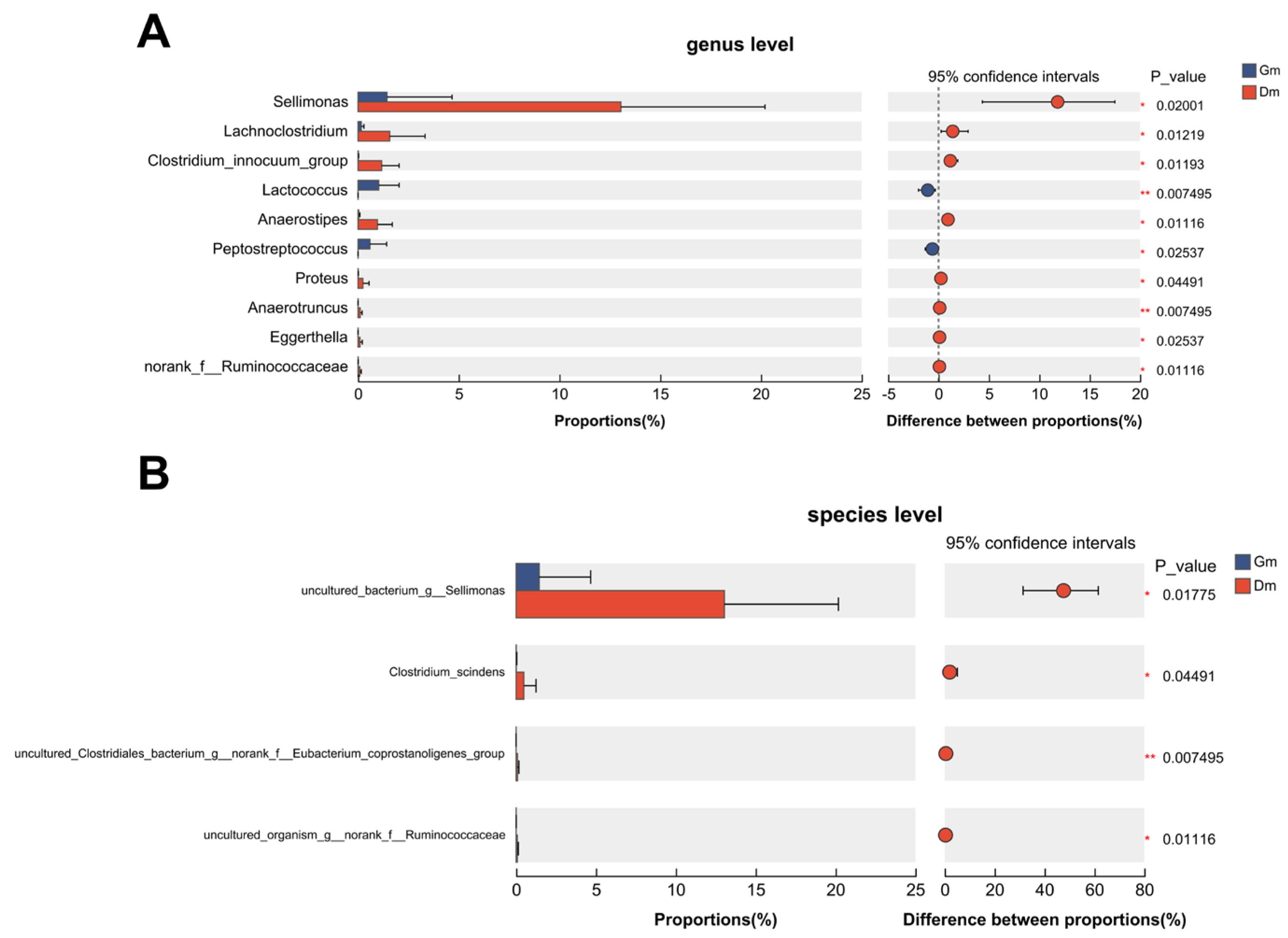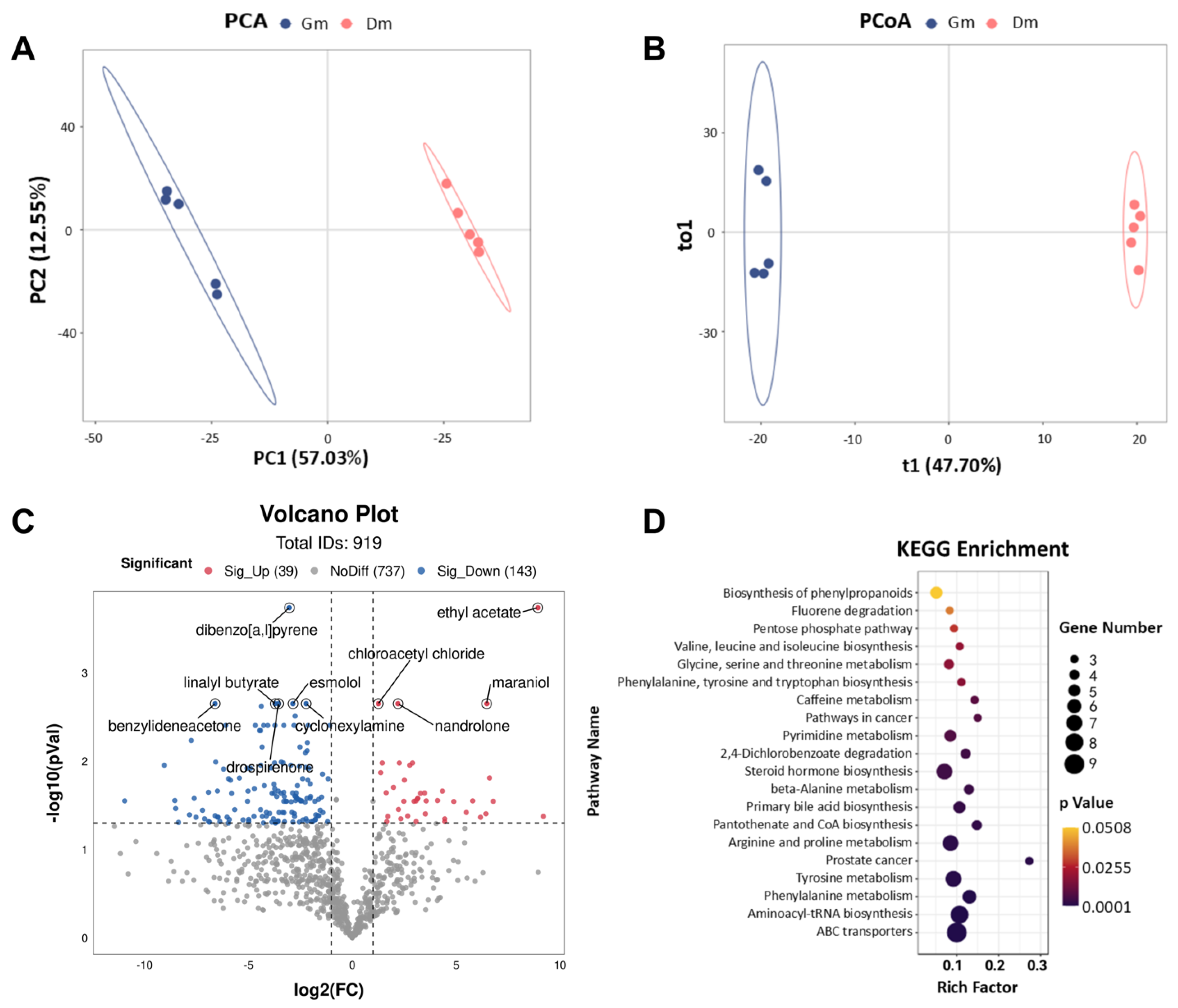Uncovering the Effects of Different Formulae of Milk Powders on the Fecal Microorganisms and Metabolites of Bengal Tiger (Panthera tigris spp. tigris) Cubs
Simple Summary
Abstract
1. Introduction
2. Materials and Methods
2.1. Animals and Diet
2.2. Fecal and Milk Powder Sample Collection
2.3. Compositional Analysis of Milk Powders
2.4. Analysis of Amino Acid Content of Milk Powder Samples
2.5. 16S rDNA Gene Amplicons
2.6. Fecal Metabolomics Analysis
2.7. Statistical Analysis
3. Results
3.1. Milk Powder Ingredient
3.2. Weight Changes in Bengal Tiger Cubs
3.3. Fecal Microorganisms in Bengal Tiger Cubs
3.4. Effects of Different Milk Powders on the Fecal Metabolic Profiles of Tiger Cubs
3.5. Correlation of Fecal Metabolites with Gut Microbes
4. Discussion
5. Conclusions
Supplementary Materials
Author Contributions
Funding
Institutional Review Board Statement
Informed Consent Statement
Data Availability Statement
Conflicts of Interest
References
- Mukul, S.A.; Alamgir, M.; Sohel, M.; Pert, P.L.; Herbohn, J.; Turton, S.M.; Khan, M.; Munim, S.A.; Reza, A.; Laurance, W.F. Combined effects of climate change and sea-level rise project dramatic habitat loss of the globally endangered Bengal tiger in the Bangladesh Sundarbans. Sci. Total Environ. 2019, 663, 830–840. [Google Scholar] [PubMed]
- Walston, J.; Robinson, J.G.; Bennett, E.L.; Breitenmoser, U.; Da, F.G.; Goodrich, J.; Gumal, M.; Hunter, L.; Johnson, A.; Karanth, K.U.; et al. Bringing the tiger back from the brink-the six percent solution. PLoS Biol. 2010, 8, e1000485. [Google Scholar]
- Ripple, W.J.; Estes, J.A.; Beschta, R.L.; Wilmers, C.C.; Ritchie, E.G.; Hebblewhite, M.; Berger, J.; Elmhagen, B.; Letnic, M.; Nelson, M.P.; et al. Status and ecological effects of the world’s largest carnivores. Science 2014, 343, 1241484. [Google Scholar] [PubMed]
- GTI. Global Tiger Recovery Program (2010–2022); World Bank Group: Washington, DC, USA, 2022. (In English) [Google Scholar]
- Das, A.; Suvo, M.; Shaha, M.; Gupta, M.D. Genome sequencing of captive white tigers from Bangladesh. BMC Genomic Data 2024, 25, 52. [Google Scholar]
- Kang, A.; Xie, Y.; Tang, J.; Sanderson, E.W.; Ginsberg, J.R.; Zhang, E. Historic distribution and recent loss of tigers in China. Integr. Zool. 2010, 5, 335–341. [Google Scholar]
- Thursby, E.; Juge, N. Introduction to the human gut microbiota. Biochem. J. 2017, 474, 1823–1836. [Google Scholar]
- Jandhyala, S.M.; Talukdar, R.; Subramanyam, C.; Vuyyuru, H.; Sasikala, M.; Nageshwar, R.D. Role of the normal gut microbiota. World J. Gastroenterol. 2015, 21, 8787–8803. [Google Scholar]
- Sekirov, I.; Russell, S.L.; Antunes, L.C.; Finlay, B.B. Gut microbiota in health and disease. Physiol. Rev. 2010, 90, 859–904. [Google Scholar] [CrossRef]
- La Rosa, P.S.; Warner, B.B.; Zhou, Y.; Weinstock, G.M.; Sodergren, E.; Hall-Moore, C.M.; Stevens, H.J.; Bennett, W.J.; Shaikh, N.; Linneman, L.A.; et al. Patterned progression of bacterial populations in the premature infant gut. Proc. Natl. Acad. Sci. USA 2014, 111, 12522–12527. [Google Scholar]
- Yatsunenko, T.; Rey, F.E.; Manary, M.J.; Trehan, I.; Dominguez-Bello, M.G.; Contreras, M.; Magris, M.; Hidalgo, G.; Baldassano, R.N.; Anokhin, A.P.; et al. Human gut microbiome viewed across age and geography. Nature 2012, 486, 222–227. [Google Scholar]
- Staude, B.; Oehmke, F.; Lauer, T.; Behnke, J.; Gopel, W.; Schloter, M.; Schulz, H.; Krauss-Etschmann, S.; Ehrhardt, H. The Microbiome and Preterm Birth: A Change in Paradigm with Profound Implications for Pathophysiologic Concepts and Novel Therapeutic Strategies. Biomed Res. Int. 2018, 2018, 7218187. [Google Scholar]
- Liu, C.; Zhao, D.; Ma, W.; Guo, Y.; Wang, A.; Wang, Q.; Lee, D.J. Denitrifying sulfide removal process on high-salinity wastewaters in the presence of Halomonas sp. Appl. Microbiol. Biotechnol. 2016, 100, 1421–1426. [Google Scholar] [PubMed]
- Bolyen, E.; Rideout, J.R.; Dillon, M.R.; Bokulich, N.A.; Abnet, C.C.; Al-Ghalith, G.A.; Alexander, H.; Alm, E.J.; Arumugam, M.; Asnicar, F.; et al. Reproducible, interactive, scalable and extensible microbiome data science using QIIME 2. Nat. Biotechnol. 2019, 37, 852–857. [Google Scholar] [CrossRef] [PubMed]
- Callahan, B.J.; McMurdie, P.J.; Rosen, M.J.; Han, A.W.; Johnson, A.J.A.; Holmes, S.P. DADA2: High-resolution sample inference from Illumina amplicon data. Nat. Methods 2016, 13, 581–583. [Google Scholar] [CrossRef]
- Yang, K.; Deng, X.; Jian, S.; Zhang, M.; Wen, C.; Xin, Z.; Zhang, L.; Tong, A.; Ye, S.; Liao, P.; et al. Gallic Acid Alleviates Gut Dysfunction and Boosts Immune and Antioxidant Activities in Puppies Under Environmental Stress Based on Microbiome-Metabolomics Analysis. Front. Immunol. 2021, 12, 813890. [Google Scholar] [CrossRef]
- Sun, Q.; Zhou, Q.; Ge, S.; Liu, L.; Li, P.; Gu, Q. Effects of Maternal Diet on Infant Health: A Review Based on Entero-Mammary Pathway of Intestinal Microbiota. Mol. Nutr. Food Res. 2024, 68, e2400077. [Google Scholar]
- Liu, W.; Feng, J.Q.; Fan, A.Q.; Zhang, M.J.; Zhou, Y.L.; Liu, T.; Xu, Y.J. The composition of gut microbiota in infant and its influencing factors. Zhonghua Yu Fang Yi Xue Za Zhi 2017, 51, 453–456. [Google Scholar]
- Beller, L.; Deboutte, W.; Falony, G.; Vieira-Silva, S.; Tito, R.Y.; Valles-Colomer, M.; Rymenans, L.; Jansen, D.; Van Espen, L.; Papadaki, M.I.; et al. Successional Stages in Infant Gut Microbiota Maturation. mBio 2021, 12, e0185721. [Google Scholar]
- Chen, W.; Guo, K.; Huang, X.; Zhang, X.; Li, X.; Chen, Z.; Wang, Y.; Wang, Z.; Liu, R.; Qiu, H.; et al. The Association of Neonatal Gut Microbiota Community State Types with Birth Weight. Children 2024, 11, 770. [Google Scholar] [CrossRef]
- Liu, W.; Zhang, J.; Wu, C.; Cai, S.; Huang, W.; Chen, J.; Xi, X.; Liang, Z.; Hou, Q.; Zhou, B.; et al. Corrigendum: Unique Features of Ethnic Mongolian Gut Microbiome revealed by metagenomic analysis. Sci. Rep. 2017, 7, 39576. [Google Scholar] [CrossRef]
- Chu, D.M.; Antony, K.M.; Ma, J.; Prince, A.L.; Showalter, L.; Moller, M.; Aagaard, K.M. The early infant gut microbiome varies in association with a maternal high-fat diet. Genome Med. 2016, 8, 77. [Google Scholar] [CrossRef] [PubMed]
- Zafar, H.; Saier, M.J. Gut Bacteroides species in health and disease. Gut Microbes 2021, 13, 1–20. [Google Scholar] [CrossRef] [PubMed]
- He, F.; Liu, D.; Zhai, J.; Zhang, L.; Ma, Y.; Xu, Y.; Rong, K.; Ma, J. Metagenomic analysis revealed the effects of goat milk feeding and breast feeding on the gut microbiome of Amur tiger cubs. Biochem. Biophys. Res. Commun. 2018, 503, 2590–2596. [Google Scholar] [CrossRef]
- Holland, A.; Galardi, E.G.; Fabbroni, M.; Hashmi, A.; Catinaud, J.; Preziosi, R.; Brereton, J.E.; Quintavalle, P.G. Exploration of Social Proximity and Behavior in Captive Malayan Tigers and Their Cubs. Animals 2023, 13, 1040. [Google Scholar] [CrossRef]
- Sun, Y.; Yao, J.; Zhang, M.; Chen, T.; Xu, W.; Fu, W.; Wu, Q.; Li, Y.; Chen, X.; Zhu, Y.; et al. Colonization and Development of the Fecal Microflora of South China Tiger Cubs (Panthera tigris amoyensis) by Sequencing of the 16S rRNA Gene. Microb. Physiol. 2022, 32, 18–29. [Google Scholar] [CrossRef] [PubMed]
- Opsomer, H.; Liesegang, A.; Brugger, D.; Wichert, B. Growth Curves and Body Condition of Young Cats and Their Relation to Maternal Body Condition. Animals 2022, 12, 1373. [Google Scholar] [CrossRef]
- NAIDENKO. SV Body mass dynamics in Eur asian lynxLynx lynx kittens during lactation. Acta Theriol. 2006, 51, 91–98. [Google Scholar] [CrossRef]
- He, T.; Venema, K.; Priebe, M.G.; Welling, G.W.; Brummer, R.J.; Vonk, R.J. The role of colonic metabolism in lactose intolerance. Eur. J. Clin. Investig. 2008, 38, 541–547. [Google Scholar] [CrossRef]
- Zhu, Y.; Zheng, X.; Cong, Y.; Chu, H.; Fried, M.; Dai, N.; Fox, M. Bloating and distention in irritable bowel syndrome: The role of gas production and visceral sensation after lactose ingestion in a population with lactase deficiency. Am. J. Gastroenterol. 2013, 108, 1516–1525. [Google Scholar] [CrossRef]
- Binder, H.J. Role of colonic short-chain fatty acid transport in diarrhea. Annu. Rev. Physiol. 2010, 72, 297–313. [Google Scholar] [CrossRef]
- Nocerino, R.; Pezzella, V.; Cosenza, L.; Amoroso, A.; Di Scala, C.; Amato, F.; Iacono, G.; Canani, R.B. The controversial role of food allergy in infantile colic: Evidence and clinical management. Nutrients 2015, 7, 2015–2025. [Google Scholar] [CrossRef] [PubMed]
- Lange, R.R.; Lima, L.; Fruhvald, E.; Da, S.V.; de Souza, A.S.; Montiani-Ferreira, F. Cataracts and strabismus associated with hand rearing using artificial milk formulas in Bengal tiger (Panthera tigris spp. tigris) cubs. Open Vet. J. 2017, 7, 23–31. [Google Scholar] [PubMed]
- Hamer, H.M.; Jonkers, D.; Venema, K.; Vanhoutvin, S.; Troost, F.J.; Brummer, R.J. Review article: The role of butyrate on colonic function. Aliment. Pharmacol. Ther. 2008, 27, 104–119. [Google Scholar] [CrossRef] [PubMed]
- Bui, T.; Manneras-Holm, L.; Puschmann, R.; Wu, H.; Troise, A.D.; Nijsse, B.; Boeren, S.; Backhed, F.; Fiedler, D.; DeVos, W.M. Conversion of dietary inositol into propionate and acetate by commensal Anaerostipes associates with host health. Nat. Commun. 2021, 12, 4798. [Google Scholar]
- Hernandez-Calderon, P.; Wiedemann, L.; Benitez-Paez, A. The microbiota composition drives personalized nutrition: Gut microbes as predictive biomarkers for the success of weight loss diets. Front. Nutr. 2022, 9, 1006747. [Google Scholar] [CrossRef]
- Nogal, A.; Louca, P.; Zhang, X.; Wells, P.M.; Steves, C.J.; Spector, T.D.; Falchi, M.; Valdes, A.M.; Menni, C. Circulating Levels of the Short-Chain Fatty Acid Acetate Mediate the Effect of the Gut Microbiome on Visceral Fat. Front. Microbiol. 2021, 12, 711359. [Google Scholar] [CrossRef]
- Yutin, N.; Galperin, M.Y. A genomic update on clostridial phylogeny: Gram-negative spore formers and other misplaced clostridia. Environ. Microbiol. 2013, 15, 2631–2641. [Google Scholar]
- Price, P.M. Pyoderma caused by Peptostreptococcus tetradius in a pup. J. Am. Vet. Med. Assoc. 1991, 198, 1649–1650. [Google Scholar]
- Uhlmann, E.J.; Seed, P.C.; Schwan, T.G.; Storch, G.A. Tick-borne relapsing fever polymerase chain reaction of tick-borne relapsing fever caused by Borrelia hermsii. Pediatr. Infect. Dis. J. 2007, 26, 267–269. [Google Scholar]
- Yang, K.; Jian, S.; Guo, D.; Wen, C.; Xin, Z.; Zhang, L.; Kuang, T.; Wen, J.; Yin, Y.; Deng, B. Fecal microbiota and metabolomics revealed the effect of long-term consumption of gallic acid on canine lipid metabolism and gut health. Food Chem. X 2022, 15, 100377. [Google Scholar]
- He, Y.; Tian, Y.; Xiong, H.; Deng, Z.; Zhang, H.; Guo, F.; Sun, Y. Rice Protein Peptides Ameliorate DSS-Induced Cognitive Impairment and Depressive Behavior in Mice by Modulating Phenylalanine Metabolism and the BDNF/TRKB/CREB Pathway. J. Agric. Food. Chem. 2024, 72, 19812–19825. [Google Scholar] [PubMed]
- Miyahara, Y.; Funahashi, H.; Naono-Nakayama, R.; Haruta-Tsukamoto, A.; Muroi, C.; Kogoh, Y.; Nishimori, T.; Ishida, Y. Serotonin and noradrenaline modulate chronic itch processing in mice. Eur. J. Pharmacol. 2020, 883, 173319. [Google Scholar] [PubMed]
- DeNapoli, J.S.; Dodman, N.H.; Shuster, L.; Rand, W.M.; Gross, K.L. Effect of dietary protein content and tryptophan supplementation on dominance aggression, territorial aggression, and hyperactivity in dogs. J. Am. Vet. Med. Assoc. 2000, 217, 504–508. [Google Scholar] [PubMed]
- Pajares, M.A. Amino Acid Metabolism and Disease. Int. J. Mol. Sci. 2023, 24, 11935. [Google Scholar] [CrossRef]





| Index | Goat Milk Replacer Powder | Dog Milk Replacer Powder |
|---|---|---|
| Milk fat (g/100 mL) | 4.73 | 6.01 |
| Milk protein (g/100 mL) | 4.80 | 3.61 |
| Lactose (g/100 mL) | 6.94 | 5.19 |
| Index | Goat Milk Replacer Powder | Dog Milk Replacer Powder |
|---|---|---|
| Lysine | 14.11% | 12.04% |
| Arginine | 5.58% | 5.24% |
| Glycine | 2.93% | 2.32% |
| Serin | 6.91% | 5.82% |
| Threonine | 11.65% | 8.55% |
| Glutamic acid | 43.73% | 45.68% |
| Proline | 0.03% | 0.03% |
| Valine | 4.28% | 3.88% |
| Histidine | 3.09% | 3.67% |
| Tyrosine | 3.59% | 5.71% |
| Methionine | 4.09% | 7.05% |
| Tryptophan | 0.0005% | 0.0005% |
Disclaimer/Publisher’s Note: The statements, opinions and data contained in all publications are solely those of the individual author(s) and contributor(s) and not of MDPI and/or the editor(s). MDPI and/or the editor(s) disclaim responsibility for any injury to people or property resulting from any ideas, methods, instructions or products referred to in the content. |
© 2025 by the authors. Licensee MDPI, Basel, Switzerland. This article is an open access article distributed under the terms and conditions of the Creative Commons Attribution (CC BY) license (https://creativecommons.org/licenses/by/4.0/).
Share and Cite
He, X.; Xiao, T.; Fang, J.; Zhang, P.; Luo, S.; Han, S.; Wu, Y.; Li, L.; Cao, Z.; Ji, Y.; et al. Uncovering the Effects of Different Formulae of Milk Powders on the Fecal Microorganisms and Metabolites of Bengal Tiger (Panthera tigris spp. tigris) Cubs. Animals 2025, 15, 1053. https://doi.org/10.3390/ani15071053
He X, Xiao T, Fang J, Zhang P, Luo S, Han S, Wu Y, Li L, Cao Z, Ji Y, et al. Uncovering the Effects of Different Formulae of Milk Powders on the Fecal Microorganisms and Metabolites of Bengal Tiger (Panthera tigris spp. tigris) Cubs. Animals. 2025; 15(7):1053. https://doi.org/10.3390/ani15071053
Chicago/Turabian StyleHe, Xuanzhen, Tingting Xiao, Jing Fang, Peng Zhang, Shenghui Luo, Sufang Han, Yuansheng Wu, Lizhen Li, Zhihao Cao, Yuhan Ji, and et al. 2025. "Uncovering the Effects of Different Formulae of Milk Powders on the Fecal Microorganisms and Metabolites of Bengal Tiger (Panthera tigris spp. tigris) Cubs" Animals 15, no. 7: 1053. https://doi.org/10.3390/ani15071053
APA StyleHe, X., Xiao, T., Fang, J., Zhang, P., Luo, S., Han, S., Wu, Y., Li, L., Cao, Z., Ji, Y., Dong, G., & Deng, B. (2025). Uncovering the Effects of Different Formulae of Milk Powders on the Fecal Microorganisms and Metabolites of Bengal Tiger (Panthera tigris spp. tigris) Cubs. Animals, 15(7), 1053. https://doi.org/10.3390/ani15071053






